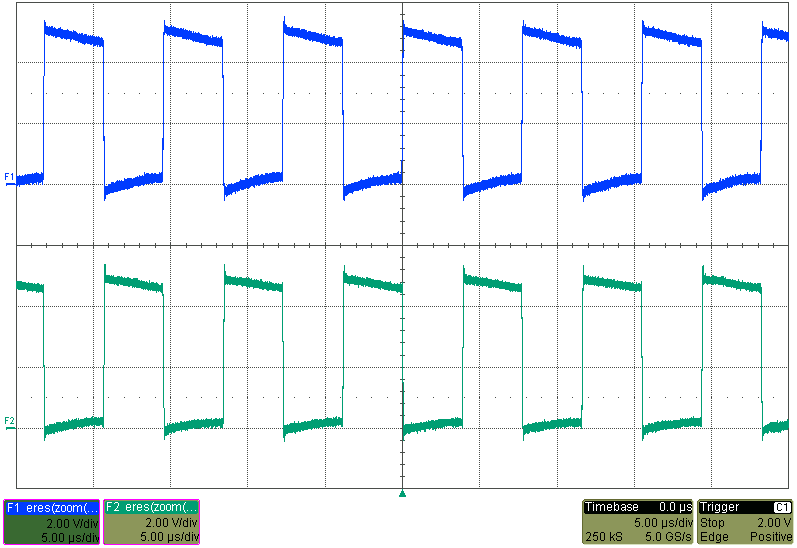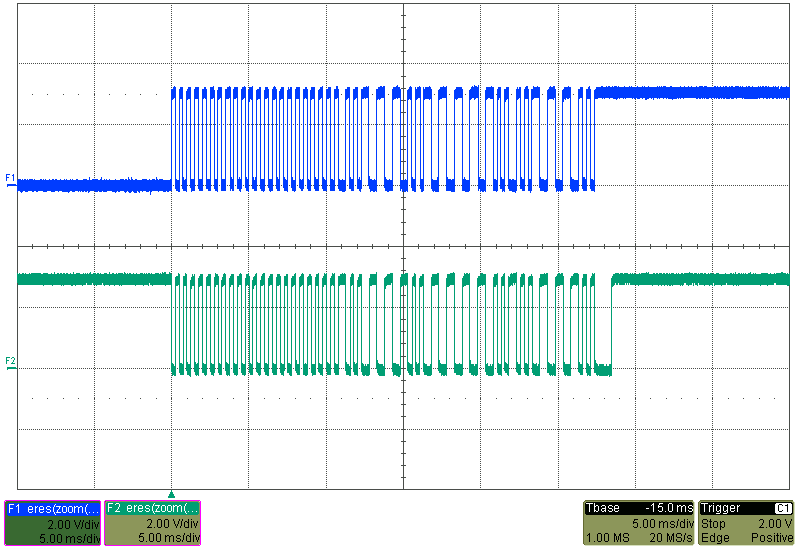ZHCSEA8A October 2015 – October 2015
PRODUCTION DATA.
6 Specifications
6.1 Absolute Maximum Ratings
over operating free-air temperature range (unless otherwise noted) (1)| MIN | MAX | UNIT | ||
|---|---|---|---|---|
| PVIN1, PVIN2 | –0.3 | 7 | V | |
| BOOT1 (2) | –0.3 | 14 | V | |
| VBOOT1 – VSW1 | –0.3 | 7 | V | |
| BOOT2 (2) | –0.3 | 14 | V | |
| VBOOT2 – VSW2 | –0.3 | 7 | V | |
| PWM1, PWM2, EN, CLK_OUT, MODE, PWM_CTRL | –0.3 | 3.6 | V | |
| DMIN1 | –5 | 7 | V | |
| DMIN2 | –0.3 | 7 | V | |
| CSN, CSP | –0.3 | 7 | V | |
| CSN to CSP | -0.5 | 0.5 | V | |
| Operating junction temperature, TJ | –40 | 125 | °C | |
| Storage temperature, Tstg | –55 | 150 | °C | |
(1) Stresses beyond those listed under Absolute Maximum Ratings may cause permanent damage to the device. These are stress ratings only, which do not imply functional operation of the device at these or any other conditions beyond those indicated under Recommended Operating Conditions. Exposure to absolute-maximum-rated conditions for extended periods may affect device reliability.
(2) In normal use, BOOT1, BOOT2 voltage internally regulated.
6.2 ESD Ratings
| VALUE | UNIT | |||
|---|---|---|---|---|
| V(ESD) | Electrostatic discharge | Human-body model (HBM), per ANSI/ESDA/JEDEC JS-001 (1) | ±1000 | V |
| Charged-device model (CDM), per JEDEC specification JESD22-C101 (2) | ±500 | V | ||
(1) JEDEC document JEP155 states that 500-V HBM allows safe manufacturing with a standard ESD control process.
(2) JEDEC document JEP157 states that 250-V CDM allows safe manufacturing with a standard ESD control process.
6.3 Recommended Operating Conditions
over operating free-air temperature range (unless otherwise noted)| MIN | NOM | MAX | UNIT | ||
|---|---|---|---|---|---|
| PVIN1, PVIN2 | 4.5 | 5 | 5.5 | V | |
| PWM1, PWM2, EN, CLK_OUT, MODE, PWM_CTRL | 0 | 3 | 3.3 | V | |
| DMIN1 | –0.3 | 5 | V | ||
| DMIN2 | –0.3 | 5 | V | ||
| CBP3 | BP3 ceramic capacitor | 2.2 | µF | ||
| CPVIN1, CPVIN2 | PVIN1, PVIN2 ceramic capacitor | 0.1 | µF | ||
| CPVIN1, CPVIN2 | PVIN1, PVIN2 electrolytic capacitor | 22 | µF | ||
| CBOOT1, CBOOT2 | SW1-BOOT1, SW2-BOOT2 capacitor | 0.1 | µF | ||
6.4 Thermal Information
| THERMAL METRIC (1) | bq50002 | UNIT | |
|---|---|---|---|
| QFN | |||
| 32 PINS | |||
| RθJA | Junction-to-ambient thermal resistance | 40.6 | °C/W |
| RθJC(top) | Junction-to-case (top) thermal resistance | 32.1 | °C/W |
| RθJB | Junction-to-board thermal resistance | 13.1 | °C/W |
| ψJT | Junction-to-top characterization parameter | 0.8 | °C/W |
| ψJB | Junction-to-board characterization parameter | 13.0 | °C/W |
| RθJC(bot) | Junction-to-case (bottom) thermal resistance | 5.7 | °C/W |
(1) For more information about traditional and new thermal metrics, see the Semiconductor and IC Package Thermal Metrics application report, SPRA953.
6.5 Electrical Characteristics
–40°C ≤ TJ ≤ 125°C, VPVIN1 = 5V, VPVIN2 = 5 V (unless otherwise noted)| PARAMETER | TEST CONDITIONS | MIN | TYP | MAX | UNIT | |
|---|---|---|---|---|---|---|
| INPUT VOLTAGE (VIN) | ||||||
| UVLO rising threshold | VIN rising | 3.75 | 3.90 | 4.20 | V | |
| UVLO falling threshold | VIN falling | 3.60 | 3.85 | 4.08 | V | |
| REGULATOR VOLTAGE (BP3) | ||||||
| BP3 output voltage | IBP3 = –5 mA, VPVIN1 = VPVIN2 = 5.0 V | 2.9 | 3.0 | 3.1 | V | |
| BP3 output voltage | IBP3 = –10 mA, VPVIN1 = VPVIN2 = 5.0 V | 2.9 | 3.0 | 3.1 | V | |
| BP3 load current max | VBP3 = 2.7 V, VPVIN1 = VPVIN2 = 5.0 V | 7.7 | 14 | 21 | mA | |
| CURRENT SENSE AMPLIFIER (CSP, CSN) | ||||||
| Current sense amplifier gain | 0°C < TJ < 85°C | 49 | 50 | 51 | V/V | |
| Current sense amplifier offset | 0°C < TJ < 85°C | -14 | 14 | mV | ||
| Input current (CSP) | VCSP = 5.0 V, VPVIN1 = VPVIN2 = 5.0 V | 1.5 | mA | |||
| Input current (CSN) | VCSN = 5.0 V, VPVIN1 = VPVIN2 = 5.0 V | 8.5 | 10.0 | 11.3 | μA | |
| EN | ||||||
| High-level input voltage | Input rising | 1.7 | 1.8 | 1.9 | V | |
| Low-level input voltage | Input falling | 0.8 | 1.0 | 1.1 | V | |
| EN pull-down resistance | EN = 3 V | 40 | 50 | 60 | kΩ | |
| PWM_CTRL | ||||||
| High-level input voltage | Input rising | 1.4 | 1.6 | 1.8 | V | |
| Low-level input voltage | Input falling | 0.9 | 1.0 | 1.1 | V | |
| PWM_CTRL pull-down resistance | PWM_CTRL = 3 V | 40 | 50 | 60 | kΩ | |
| PWM1 | ||||||
| High-level input voltage | Input rising | 1.6 | 1.8 | 1.9 | V | |
| Low-level input voltage | Input falling | 0.9 | 1.0 | 1.1 | V | |
| PWM1 pull-down resistance | PWM1 = 3 V | 40 | 50 | 60 | kΩ | |
| PWM2 | ||||||
| High-level input voltage | Input rising | 1.6 | 1.7 | 1.8 | V | |
| Low-level input voltage | Input falling | 1.0 | 1.1 | 1.2 | V | |
| PWM2 pull-down resistance | PWM2 = 3 V | 40 | 50 | 60 | kΩ | |
| MODE | ||||||
| High-level input voltage | Input rising | 1.7 | 1.8 | 1.9 | V | |
| Low-level input voltage | Input falling | 0.9 | 1.0 | 1.1 | V | |
| MODE pull-down resistance | MODE = 3 V | 40 | 50 | 60 | kΩ | |
| BOOTSTRAP DIODE (BOOT1 AND BOOT2) | ||||||
| Regulation voltage (BOOT1) | VPVIN1 = VPVIN2 = 5 V, IBOOT = 0 mA | 4.2 | 4.4 | 4.7 | V | |
| Regulation voltage (BOOT2) | VPVIN1 = VPVIN2 = 5 V, IBOOT = 0 mA | 4.9 | 5.0 | 5.1 | V | |
| UVLO (BOOT1) | VPVIN1 = VPVIN2 = 5 V | 1.8 | 2.3 | 2.7 | V | |
| UVLO (BOOT2) | VPVIN1 = VPVIN2 = 5 V | 1.8 | 2.2 | 2.6 | V | |
| MOSFETS (SW1 AND SW2) | ||||||
| SW1 high-side RDS(on) | VPVIN1 = VPVIN2 = 5 V | 59 | 76 | 107 | mΩ | |
| SW1 low-side RDS(on) | VPVIN1 = VPVIN2 = 5 V | 48 | 61 | 86 | mΩ | |
| SW2 high-side RDS(on) | VPVIN1 = VPVIN2 = 5 V | 42 | 49 | 64 | mΩ | |
| SW2 low-side RDS(on) | VPVIN1 = VPVIN2 = 5 V, ISW = 500 mA | 39 | 46 | 58 | mΩ | |
6.6 Typical Characteristics

